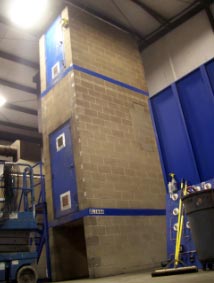There are typically two sides to any cable: performance and safety. The performance of the cable gets the most attention. Does it work? Is the cable reliable? However, most of the time, no one is talking about the safety of the cable. So, if a cable works, what is so important about cable fire testing?
Cable fire testing is important because it can prevent dangerous cable fires. If cables catch fire, they can act like a wick and spread flames throughout an entire building. In addition to spreading fire, burning cables emit smoke that is also a hazard.
But not all cables are the same, as they are typically designed for very specific applications. The types of materials and compounds used in making the cable have a major influence on its price. Twisted pair cables, used in computer networks, are classified as communication cables according to the NEC building codes Article 800. This is typically a marking printed on the cable legend by the cable manufacturer and verified by an independent testing lab. Article 800 classifies communication cables from residential to plenum use applications.
The possible markings on the cable legend are:
Plenum rated cable is the most difficult fire safety standard to meet. As you go down the list, the fire testing becomes less stringent.
 The industry test to meet the plenum cable standard is NFPA-262. This test has the most stringent requirements of all cable tests. Cabling that requires a CMP rating is typically used in the ‘plenum’ space between the structural ceiling and the dropped ceiling, or under a raised floor. The NFPA-262 test measures the flame spread, smoke average, and smoke peak of the burning cable. The actual test is conducted in a Steiner Tunnel where the cable sample is placed on a tray and burned for 20 minutes. To qualify for a plenum rating, the flame spread cannot exceed 1.5 meters (5 ft.), the smoke peak cannot exceed 0.5, and the average smoke density cannot exceed 0.15. The smoke measurements are logarithmic numbers that show how dark the smoke is.
The industry test to meet the plenum cable standard is NFPA-262. This test has the most stringent requirements of all cable tests. Cabling that requires a CMP rating is typically used in the ‘plenum’ space between the structural ceiling and the dropped ceiling, or under a raised floor. The NFPA-262 test measures the flame spread, smoke average, and smoke peak of the burning cable. The actual test is conducted in a Steiner Tunnel where the cable sample is placed on a tray and burned for 20 minutes. To qualify for a plenum rating, the flame spread cannot exceed 1.5 meters (5 ft.), the smoke peak cannot exceed 0.5, and the average smoke density cannot exceed 0.15. The smoke measurements are logarithmic numbers that show how dark the smoke is.
Although flame spread is an important factor, as you don’t want the cable to burn quickly from one room to another in plenum spaces, smoke peak and density are critical measurements when testing plenum cable. The main compound material used to make plenum cable is FEP (fluorinated ethylene propylene), which is a very expensive material. FEP material is made with halogen compounds that prevent the spread of fire. However, when FEP is burned, acidic gas is released that can mix with moisture in the air and burn the lungs.
 The industry test to meet the riser cable standard is UL-1666. Cabling that requires a CMR rating is often used in vertical runs, in a shaft, or from floor to floor, and has fire-resistant characteristics that can prevent the fire to be spread between floors. The UL-1666 industry test measures flame height and temperature. This test does not look at smoke density or toxicity. The CMR cable testing takes place in a simulated two-story vertical shaft where the cable hangs in a 5.2-meter (17-ft.) bundle. The cable bundle is ignited and burned for 30 minutes. To qualify for a riser rating, the cable bundle must have a flame spread of less than 3.7 meters (12 ft.) beyond the ignition point, and the temperature at the top of the vertical shaft cannot exceed 455 degrees Celsius (850 degrees Fahrenheit). If one of these requirements is not met, the test has failed.
The industry test to meet the riser cable standard is UL-1666. Cabling that requires a CMR rating is often used in vertical runs, in a shaft, or from floor to floor, and has fire-resistant characteristics that can prevent the fire to be spread between floors. The UL-1666 industry test measures flame height and temperature. This test does not look at smoke density or toxicity. The CMR cable testing takes place in a simulated two-story vertical shaft where the cable hangs in a 5.2-meter (17-ft.) bundle. The cable bundle is ignited and burned for 30 minutes. To qualify for a riser rating, the cable bundle must have a flame spread of less than 3.7 meters (12 ft.) beyond the ignition point, and the temperature at the top of the vertical shaft cannot exceed 455 degrees Celsius (850 degrees Fahrenheit). If one of these requirements is not met, the test has failed.
The purpose of this test is to prevent the cables from moving and to minimize the flame spread and heat between floors in a commercial building. If the bundled cable sample meets the CMR rating, the flame will fire up the vertical bundle slightly, eventually fall down, and extinguish by itself.
 The industry test to meet the general purpose cable standard is UL-1685. Cabling that requires a CM rating is suitable for installation in cable trays and other non-plenum/non-riser areas. An example of a very common CM cable is the RJ-45 Ethernet patch cable. The UL-1685 test only measures flame height. It does not measure smoke density, toxicity, or temperature. During the actual test, cables samples are tied to a 2.5-meter (8-ft.) tray, placed in a vertical chamber, and burned for 20 minutes. The samples pass the test if the flame spread does not extend to the upper portion and extinguish by itself.
The industry test to meet the general purpose cable standard is UL-1685. Cabling that requires a CM rating is suitable for installation in cable trays and other non-plenum/non-riser areas. An example of a very common CM cable is the RJ-45 Ethernet patch cable. The UL-1685 test only measures flame height. It does not measure smoke density, toxicity, or temperature. During the actual test, cables samples are tied to a 2.5-meter (8-ft.) tray, placed in a vertical chamber, and burned for 20 minutes. The samples pass the test if the flame spread does not extend to the upper portion and extinguish by itself.
Lastly, a residential cable features the lowest-level flame test in the NEC Article 800. The industry test used for testing residential cables is the VW-1 test or Vertical Wire Flame 1 test. The most common CMX cables are your keyboard and mouse cables. These are cables that are typically never used in areas where there is a risk to a person if ignited. The VW-1, sometimes referred to as the Bunsen Burner test, is a simple test in which a Bunsen Burner flame is applied to an individual cable bundle for a short period of time. During the test, a technician examines whether the cable ignites or not. This is a very low-level test.
As you go down the Article 800 chart for communication cables, the flame test requirements become less stringent. Less stringent test requirements usually come with a less expensive cable. This is because the materials and compounds used to make a CMP cable cost more than those used for making a CM or CMX cable. In addition, there is a certain order in the NEC Article 800 chart. While no CMR cable can be used in a CMP application, a CMP cable can be used in a CMR application.
Note, that some non-recognized cable brands may have false cable legends printed on the cable, trying to make a CMR cable pass as a CMP. Do not be fooled. If the price of a cable or bulk cable box is too good to be true, it usually is. To find out more, watch our video “”

Product Engineer
Steve Molek has 27 years’ experience in the cabling and connectivity data communication industry. He started his career as a Technical Support Representative and now works as a Project Engineer for Black Box. As a Product Engineer, his primary focus is evaluating and testing all new cabling and connectivity products for sale by Black Box and training our inside technical support and sales teams. Steve also works directly with our domestic and international OEM suppliers as well as several nationally recognized third-party testing labs. Steve holds a B.S. degree in Mathematics and Computer Science from California University of Pennsylvania and an MBA from Waynesburg University.